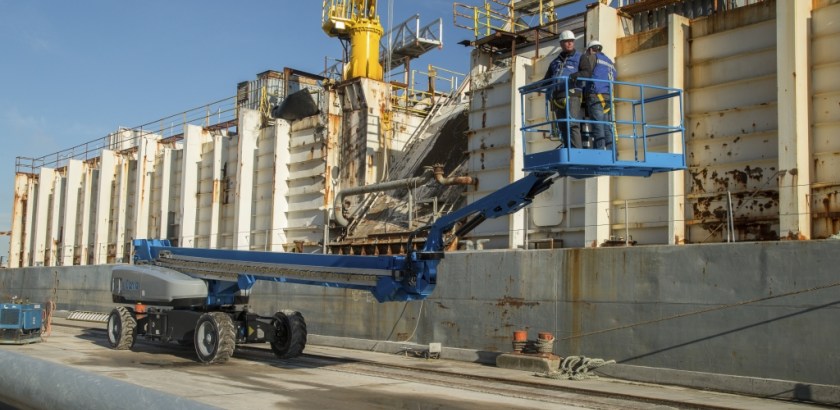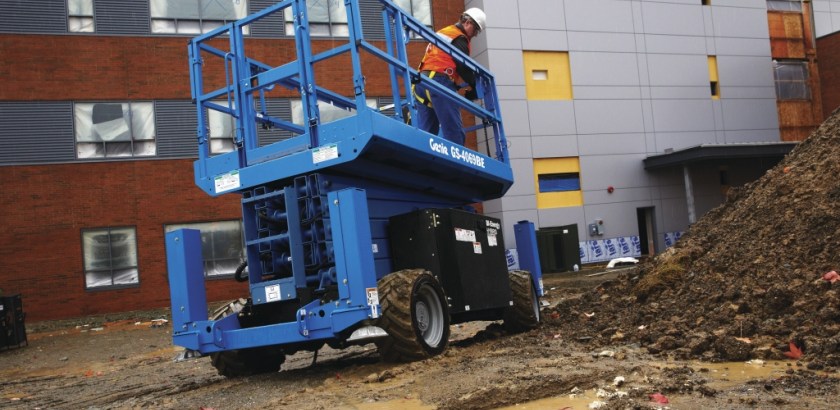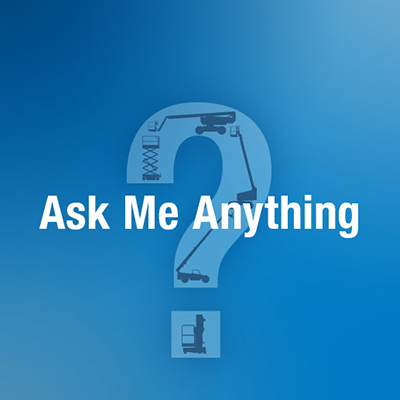ANSI A92 | CSA B354 Ask Me Anything Jan 23rd – 27th
by Genie On Jan 23, 2017, 03:00 AM
Subscribe To Aerial Pros
Filter by tags
A huge thank you to everyone that participated in the ANSI A29/CSA B354 Ask Me Anything with the Genie Team! Stay tuned to Genie Aerial Pros and our social media channels for the next Ask Me Anything Session.
----------------------------------------------------------------------------------------------------------------------------------------------------------------
Welcome to Ask Me Anything with the Genie Team on the upcoming ANSI A92/ CSA B354 changes. Below is a brief overview of the upcoming changes:
Additional articles can be found by clicking on "Current News" and selecting "MEWP Standard".
To ask your question:
Scroll to the bottom of the page and ask your question in the Comment section, be sure to include your Name and Email Address. Check back over the course of the week for answers to your ANSI A92 / CSA B354 questions!
You can view the Q & A below from this event:
Q: When can the public sign up for the first Train-the-Trainer Class with the updated content? I would like to be put in the class as soon as possible.
A: We are currently updating the Train the Trainer courses, we expect to release them shortly after the new standards are published later this year.
More information will be available on genielift.com and liftpro.genielift.com when the updated courses are available.
Q: What are the A92-2 requirements for a bucket truck annual? Is there an inspection guideline available?
A: The A92.2 standard itself contains the annual inspection criteria for bucket truck. The machine’s service manual also contains the annual inspection requirements. Contact Terex Utilities at 605-882-4000 or utilities.info@terex.com to request a manual.
Q: 1) What type of fall protection system is acceptable in a scissor lift according to Genie? I realize by law none is required when the guardrails and gate are in place, but some job sites or employers do require it, that being said was is both recommended and what would be acceptable. As a side note, what, would not be acceptable?
2) What type of fall protection system is acceptable in a scissor lift according to Genie? I realize by law none is required, but some job sites or employers do require it, that being said was is both recommended and what would be acceptable. As a side note, what, would not be acceptable?
3) What is Genie’s policy on leaving the MEWP while elevated and what suggestions do you have if this practice is considered acceptable?
4) Can an operator rely on the MEWP for fall protection when they are not in the platform, if so what precautions need to be taken?
A: 1.) & 2.) The primary means of fall protection on all aerial lifts is provided by the platform guardrails. Additional personal fall protective equipment (PFPE) is not required when operating a scissor lift. The platform guardrails are not approved attachment anchors for PFPE on any Genie aerial platforms. Only designated anchors may be used for PFPE. All anchor locations on Genie Booms and Scissors are designed to hold 5000 pound static load. Safe and appropriate use of personal fall protection equipment on any aerial lift is the responsibility of the operator and user (employer): Below are some acceptable forms of PFPE for use on scissor lifts:
Ø Full body harness with fall restraint system.
Ø Full body harness with self‐retracting lifeline/lanyard (6 foot shock absorbing) system.
Ø Body belt with fall restraint arranged so that the employee is not exposed to falling any distance outside the platform.
3.) & 4.) Genie recommends that operator’s do not enter or exit the platform unless the machine is in the stowed position and the platform is at ground level. For special circumstances, Genie does provide additional criteria for operators who wish to exit a boom and remained tie-off to the platform. Click the link below to download this guidance document: http://manuals.gogenielift.com/Operators/english/233990.pdf
Q: 1) When will the new ANSI manuals for be available through parts. So far, no one I’ve asked in parts knows about the coming changes. Parts look up shows 2006 manuals in photo. Ahmed was able to confirm they 2006 manual is what is still available.
2) When we do repairs and inspections are we supposed to change out manuals?
3) How many different manuals will there be? Currently there are 4 that apply to personnel lifts.
A: 1) The updated ANSI Manual of Responsibilities will not be available until after the new standards have published which is anticipated to be later this year. Shortly after the standards are published the new ANSI manuals will be available.
2) The ANSI Manual of Responsibilities only needs to be replaced when a newer version is published; it does not need to be replaced when doing repairs and inspections on the equipment.
3) The manuals that apply to Genie’s personnel lifts (e.g. AWP, IWP, DPL and GR series products) are: (1) Operator’s, (2) Parts, (3) Service, (4) AEM Safety Manual (North American machines only) and (5) ANSI Manual of Responsibilities (North American machines only).
Q: I have a request for a lift that will fit 36 inch wide gates and react 65 feet high. Is that possible?
A: Hey Pat, This sounds like an interesting application, though Genie currently does not have a product solution that would meet both those criteria, there are specialty machines (atrium lifts come to mind) that may be able to get you where you need to work – safely! You should reach out to your rental partner for specific offerings that they may have to meet your needs.
Q: Sounds like you will have a computer system of some sort to monitor weight of load in basket and ground angle. Seems you could put a wind speed measuring system on also.
Perhaps you should also design a computer system that also does a function check on turning on the key for the system. Any errors found in the system would “Brick” (make the lift non responsive, and pop a screen up that says contact Geni for service, system not operational at this time) the system.
With sensors on the basket, base, and boom this would prevent collisions (not eliminate, but prevent) with equipment, structures, and people.
Also a card swipe or password protection could be put on the lifts so that when someones authorization has expired to use the equipment the user would be notified.
Will this be in the new systems?
A: You are correct, just like the auto industry, as equipment advances with computers we have more control over what we can measure and how we can control the machines. Many of our newest control systems do perform a startup check of critical sensors like you suggest. As with most electronic devices we interact with, it’s a careful balance between functionality, and simplicity. Genie does offer a anemometer option on some machines as a tool to inform the operator about the environment they are in. I should note that a jobsite inspection, including wind condition, is a critical part of working safely on any job.
As far as your question on sensors in the basket and operator access, aerial equipment continues to evolve and secondary guarding has been a major topic within the last couple of years. As the technology becomes mature and jobsite requirements become further defined I think we will see more advanced devices become commonplace.
Q: Has a decision been made as to whether or not an expiration date will be implemented on MEWP training?
A: The new training standard does not prescribe a specific training interval; however, retraining should be performed when the user (employer) determines that the operator’s performance has deteriorated or if they were involved in an accident or near-accident, if it has been an extended period of time since the operator last used the type of equipment, or if the equipment is different from the type of equipment the operator has experience and training on.
Q: This is a question from one of our customers:
With regards to the loads of the manlifts. You and I, we are supposed to train our people to set equipment up on “good soil”/ (ANSI A92.6-R 2014 (35) manual says: The user shall ensure the support surface is adequate for the aerial platform and the load required. That’s where the training however stops in the entire industry.
Example: tire loads for 125’s to 135’s are listed in the manual to be 25000# or 105 PSI ( pounds per square inch)
In the soils world, soil is tested per square foot for our loads. So if you take 105 PSI x 144 ( 1 sq ft) this number equals 15,120# per square foot.
Now I am no expert in this, but it’s been a long time that I have seen any soil better than 6000# per square foot as documented by soils entities.
Surface soil, black dirt has 0 value.
So, when firms that want the owners to be responsible for adequate soils ( foundations) for machines to be used technically there will be a problem based on load values given to me over all the years. The unknown thing may be what the value of the soil is temporary?????Don’t know
But from where I come from when I see “others” using manlifts on lawns, soft soils, etc I dont know what keeps them from tipping over but I haven’t really seen one tip.
Now, lets say one does, and the cause of failure was “not adequate soil support” who or how will this get defined?
I have this same question out to many others in this industry, and I know it’s going on deaf ears or they think I am crazy, however am I?
They simply don’t respond, therefore the reason I have not signed off on some documents many want me to. Maybe they don’t want to know???
But from the teaching perspective, the loads published on the ground is 105# per square inch which is 15,120# per square foot……..
Perhaps you could dig further as I have run out of resources……………
If one states that the soils people are that conservative or there is some code out there telling them the “rules” so be it.
All I can tell you is what I know and that I have been trying to get this question answered now since 2011.
A: Thanks for your inquiry regarding safe use of Genie machines. Ensuring your jobsite has adequate ground conditions to support the loads imposed by the machine is a key piece of the workplace inspection found in the machine’s operators manual. In particular, as some of the bigger machines move off of hard pavement and onto dirt, it may be necessary to make modifications to the jobsite ground conditions (i.e. spreading the load). Note: the floor loading information provided with the machine is approximate and does not incorporate different option configurations. It should be used only with adequate safety factors.
Q: What ANSI requirements are there currently and what changes have been made for the A92 in regards to guarding tools, equipment and material from falling out of both scissors and booms to lower working levels?
Is it required to screen or guard the doorway and or sides of platform since material is within 8ft of the doorway. This OSHA policy applies to scaffold does it also apply to MEWPs?
If material, storage buckets or tool bags are being stored in platform while work is being performed at height does an artificial toe board need to be erected or installed at the entry of platforms?
A: The biggest change to the standard in this specific category has to do with the platform toeguards. Specifically, all new machines built AFTER the standard goes into effect will be required to have a minimum of a 4″ toeguard at the entry. Previously the standard allowed the manufacturers to omit this toeguard requirement at the entry. There is no requirement about additional screening or guarding of the platform; however, Genie does offer options and accessories straight from the factory like half mesh or panel cradles to help secure platform loads.
Q: As far as training goes, will employees need to be fully trained on the new standard or just up dated and then full training when needing to be redone.
A: Thanks for your inquiry regarding safe use of Genie machines. Only the new content of the ANSI standards (A92.22 & A92.24) would need to be covered in a training course provided the trainee(s) is properly trained to safely operate a machine under the existing/current ANSI standards.
Q: I’ve heard a lot of mixed stories about what is changing and what is not changing and its been both confusing and overwhelming. I frequently rent 40 and 60 foot sticks in the central Florida area – always with sand tires. Is it true that air tires will no longer be available? The people creating these standards….have they ever tried driving a 20,000 lb machine over fine sugar sand. Lug tires are bad enough…but with foam???
I guess I better prepare to pay more for those older machines
Also….these safety bars …are they part of these new standards?
A: Thank you for your inquiry. The new ANSI design standard doesn’t prohibit pneumatic tires. There are additional requirements in the new standard that must take into account the stability performance of the machine in a flat tire situation. Manufacturer’s must take into account these new requirements and update machines accordingly. Genie intends to offer a pneumatic tire option on select booms.
Q: What is the difference (for example) Platform Capacity 660 lb Unrestricted vs. 1,000 lb Restricted?
A: Good question, Craig! Unrestricted vs. restricted pertains to the range of motion on Genie Xtra Capacity™ boom lifts – namely maximum outreach zone and maximum capacity zone. For example, the Genie® S®-60 XC™ has an unrestricted dual lift capacity (660-lb (300 kg)) for its maximum outreach zone and a restricted capacity (1,000-lb (454 kg)) for its maximum capacity zone.
To learn more about how unrestricted vs. restricted pertains to each Genie Xtra Capacity boom lift, visit https://www.genielift.com/en/aerial-lift/xtra-capacity.
Q: When working in a Genie Aerial lift basket, is it permissible to kneel down (tied-off of course) and reach through the guardrail to perform the job. OSHA says feet need to be firmly on the floor of the basket.
A: Hi Rick! The intent of keeping both feet on the floor is to ensure the occupant is planted properly in the platform and not stepping on the rails or out the platform. Kneeling on the floor is fine. Reaching over or through the rails is fine, as long as the occupant’s weight is firmly on the floor.
Related Posts

Changes to the ANSI and CSA Standards You Need to Know About
The current ANSI and CSA standards for safe use and training have not been updated for many years (the current ANSI boom, scissor lift and manually propelled standards were last updated in 2006, and CSA standards go back even further).
Continue Reading

How are ANSI Standards for Aerial Work Platforms Enforced by OSHA?
With increases in OSHA penalties, as well as conducting more inspections to identify violations of its policies and impose the new fines, a question many in the aerial rental market are asking is: How are ANSI standards enforced by OSHA?
Continue Reading


